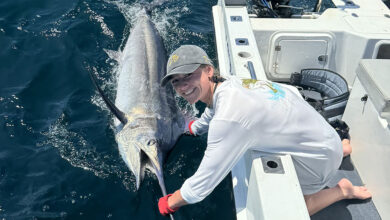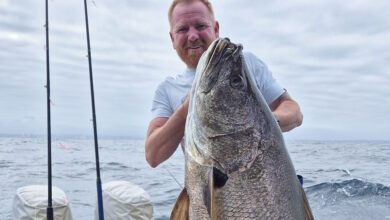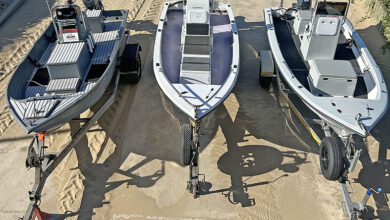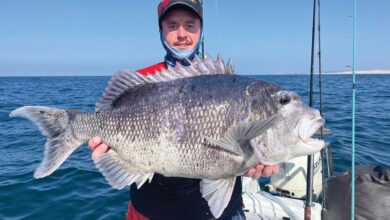SLOWLY DOES IT Part 2
All you need to know about slow pitch jigging
By Dwayne Boshoff
(Originally published in the March 2025 issue of SKI-BOAT)
IN the previous issue of SKI-BOAT I introduced readers to the concept of slow pitch jigging as opposed to speed jigging, and shared at length about all the tackle requirements. In this issue I’ll explain how to put all that tackle to good use to have some real fun out on the water.

ACTION AND RETRIEVES
There are many different methods of retrieving with slow pitch jigging. The golden rule – as with any lure fishing – is not to get stuck in a rut.
Mix up your retrieves.
You’ll hear talk of a “quarter pitch”, “half pitch”, “full pitch”, “lift and fall” and various different methods of retrieving, but it’s all quite simple: The pitch refers to the crank of the reel handle.
You need to crank the reel handle at the same time as you lift the rod, because this loads the rod in order to pitch the lure. With the pitch, the lure kicks to the side, aligning itself in a horizontal position. As you lower the rod to repeat the action, the lure starts to sink or fall and flutter, imitating a wounded baitfish.
This YouTube video shows exactly what happens to your jig underwater
Your pitch, the speed at which you retrieve, the weight of the jig and the current will all affect the jig’s movement as it falls.
Always allow short pauses between pitching the lure again, to allow for the lure’s action to take effect. Mix it up with some longer pauses to allow the lure to fall and flutter more.
I generally mix up my retrieve and the speed of my retrieves according to what I am targeting. For bottomfish, lift and fall – no retrieve. I simply lift the rod and drop it back down to creating resistance-free falling, keeping the lure within 1.5m of the bottom. For pelagics I retrieve a little faster and higher up in the water column; generally 5m to 10m off the floor. This is one colour change of your multi-coloured braid, for ease of reference. This is where the bites are at.
You’ll be amazed at how slow you can fish these jigs and how little movement is required to trigger a bite. Having said that, slow pitch jigs can be fished fast too.

WHAT TO LOOK OUT FOR
A good showing is crucial in any depth of water. I’ve jigged at depths from 10- to 120m off Durban, so don’t think you need to target a specific depth, just keep an eye on your fishfinder.
A good healthy reef system in the shallows will almost always have kingfish hanging around it, especially in the summer months. Pinnacles, drop offs, coral or structure provide shelter for smaller fish and baitfish, so the predators will hang around there to feed on them.
When I see bait showing, or even fish for that matter, on top of the reef, I get very excited. Remember that you are trying to imitate an injured baitfish, and if there’s bait down there, you have the perfect opportunity to present the weakest link.
I don’t necessarily jig all day, as there’s always lots to do on a boat, so if I’m busy with something else, Dad will often give me the heads up that there’s a good showing on the finder, then I’ll grab the jig and go down – sometimes even while slow trolling.
When you’re drifting, it’s best to turn the steering full tilt in order to ensure the boat drifts sideways. Never jig with your line going down at an angle underneath the boat, because then you’re more likely to get tip wraps.

TARGET SPECIES
With regard to species, you can really target anything – amberjack, kingfish, pelagics, bottomfish, you name it.
There are quite a few gamefish that dwell near the bottom, and for years they were never really targeted – or not successfully anyway. Anglers tried trolling plastics and lipped lures or even livebait along the surface, while others used dead baits or squid, often to no avail.
Now we have an effective method of targeting these fish and there’s a good chance of catching queenies, garrick, prodigal son, amberjack, yellowtail and other less common gamefish species.
For me, ambers are king, and those who follow me on social media will know I flood my feed with them. Although the ones off Durban are relatively small models, pound for pound they are one of the strongest fighting fish in the ocean. With the right gear, as they say in Afrikaans, “Dis jare se pret!”
Kingfish are also such cool fish and there are so many in the family that you’ll never get bored. They go hard and make for good sportfishing, I simply love them.
We’ve also caught quite a few ’cuda, snoek, yellowfin and even dorado on slow jigs, along with countless bottomfish. The point is, they will all eat a jig!

CONDITIONS
Having good conditions certainly helps, and, as with all fishing, water colour and temperature bring the gamefish on the bite. However, if the weather’s not playing ball it’s often still worth having a go, because if the water is too clean it may make artificial fishing more difficult.
Don’t be put off by green or off-colour water; we’ve caught a span of fish in that.
Watch out for a strong current or drift, as this presents a bigger problem than offcolour water. In a strong current you obviously drift off the mark quicker, have big bows in your line, or your line goes down at a big angle rather than straight down which is what you want. One also tends to get stuck a lot more when the conditions are like this.
First light is always best for fishing, but with slow pitch jigging you are not limited to fish feeding times. This goes back to the fundamentals of slow pitch jigging where you are imitating an injured baitfish rather than a fleeing baitfish. It takes a lot of effort for a fish to chase a fleeing baitfish, whereas a slow jig is an easy snack – even for a fat, lazy yellowbelly – whatever the hour of the day.
BITE DETECTION
To me, the bite on the retrieve is the highlight of the jigging experience and is what keeps me hooked.
However, you need to be alert all the time, because the bite also quite often happens on the fall due to the jig’s effective fluttering action. It is thus important to carefully watch your slack braid floating on the surface of the water. If your braid stops going down before you anticipated it would hit the floor, lift the rod because you have most likely been picked up.
My braid often suddenly starts peeling off at an increased pace while the jig is still dropping. If that happens to you, clip over – you are tight. If the braid is peeling off rapidly and you struggle to clip over, lift your rod, then lower it quickly to provide some slack so you can clip over.
CONCLUSION
Don’t be afraid to try out new things. Technology is moving at a rapid pace, and you don’t want to get left behind, because a whole new exciting offshore fishing experience awaits you.
It took me a while to get my dad into slow pitch jigging, but he recently made a statement that I’ll never forget. He said, “It’s like this slow pitch thing has re-ignited my passion for fishing.” I can assure you that passion never died, but that’s coming from someone who has been fishing for over 50 years; a man who has seen and experienced many things – even the good old days.
Experienced anglers might think the gear looks small, incapable or even funny, but it’s specifically designed for this facet of angling, so trust it.
In conclusion, I know Justin Paynter did warn you in a previous article, but I have to reiterate, that this “gogga” bites hard – harder than most of the others I’ve experienced.
If you’ve been getting a bit bored with using the same old fishing tactics and maybe not getting the results you’d hoped for, why not try slow pitch jigging to spice things up again. You can thank me later.






